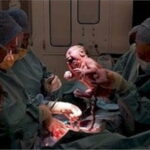Pregnancy brings about many life changing experiences and emotions. For many women, the bodily change process involved with pregnancy can be, at times, overwhelming. For many women, delivery of a newborn by cesarean section, also known as c-section, brings about additional health issues, including bodily changes, for which a woman may not have anticipated. This fact is further compounded by the complications, such as adhesions, which arise in the years following giving birth by c-section. Understanding the health complications associated with cesarean section will provide women with a better understanding of the health impact c-section will play on the remainder of their lives.
In the last few decades, c-sections, both elective and non-elective, have become increasingly popular among women. With the use of an epidural, women are provided with the necessary pain relief in the lower portion of the body, giving way to the surgical procedure known as cesarean section. In contrast to vaginal birth, a c-section will leave a scar across the abdomen of a woman, often resulting in the development of adhesions.
Adhesion is simply a medical term used to describe a scar tissue development. During c-section, after the abdominal wall is open, and birth has taken place, the surgeon will close the c-section opening with sutures into various layers of the abdominal wall. As a result of this trauma, scar tissue, known as adhesion, will develop, leading to potential complications in the abdominal area.
With adhesions, as years pass, organs within the abdominal wall typically become entangled in the adhesion or compressed by the adhesion, resulting in abdominal pain which many women describe as cramping. While these abdominal pains are not associated with menstrual cramping, while very similar, they often lead a woman to obtain a misdiagnosis in treatment.
In addition to severe abdominal pain, many women, following cesarean section, also report complications associated with fertility. While this is rare, for women who seek to become pregnant repeatedly, the risk of infertility increases with cesarean section due to the potential development or growth of scar tissue in and around the ovaries and fallopian tubes.
When complications associated with adhesions arise, following cesarean section, there are a variety of treatment options to be considered. Of these adhesion treatment options, women commonly undergo surgical removal of the adhesion through laparoscopic surgery and report great success. While this involves another surgical procedure, the removal of c-section adhesions does not involve surgical opening of the abdominal wall and, therefore, is successful in relieving abdominal pain and improving fertility options for women following cesarean section.
As a home remedy option, in relieving pain associated with adhesions, women can utilize pain relievers which contain anti-inflammatory properties so as to reduce any swelling which may temporarily flare during abdominal pain. The application of light heat, using a heating pad, may also provide temporary relief. However, for chronic pain associated with adhesions, surgery may be the only feasible option to restoring a woman’s health following c-section.
For more information regarding c-section and the risk associated with the development of adhesions, visit www.gynecare.com.





